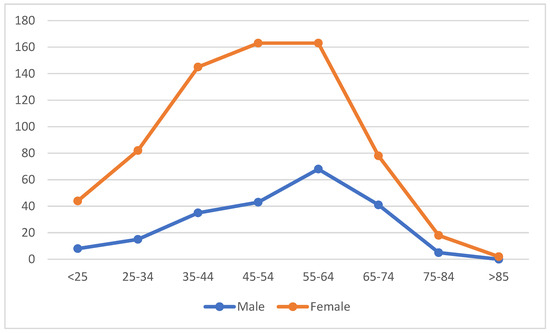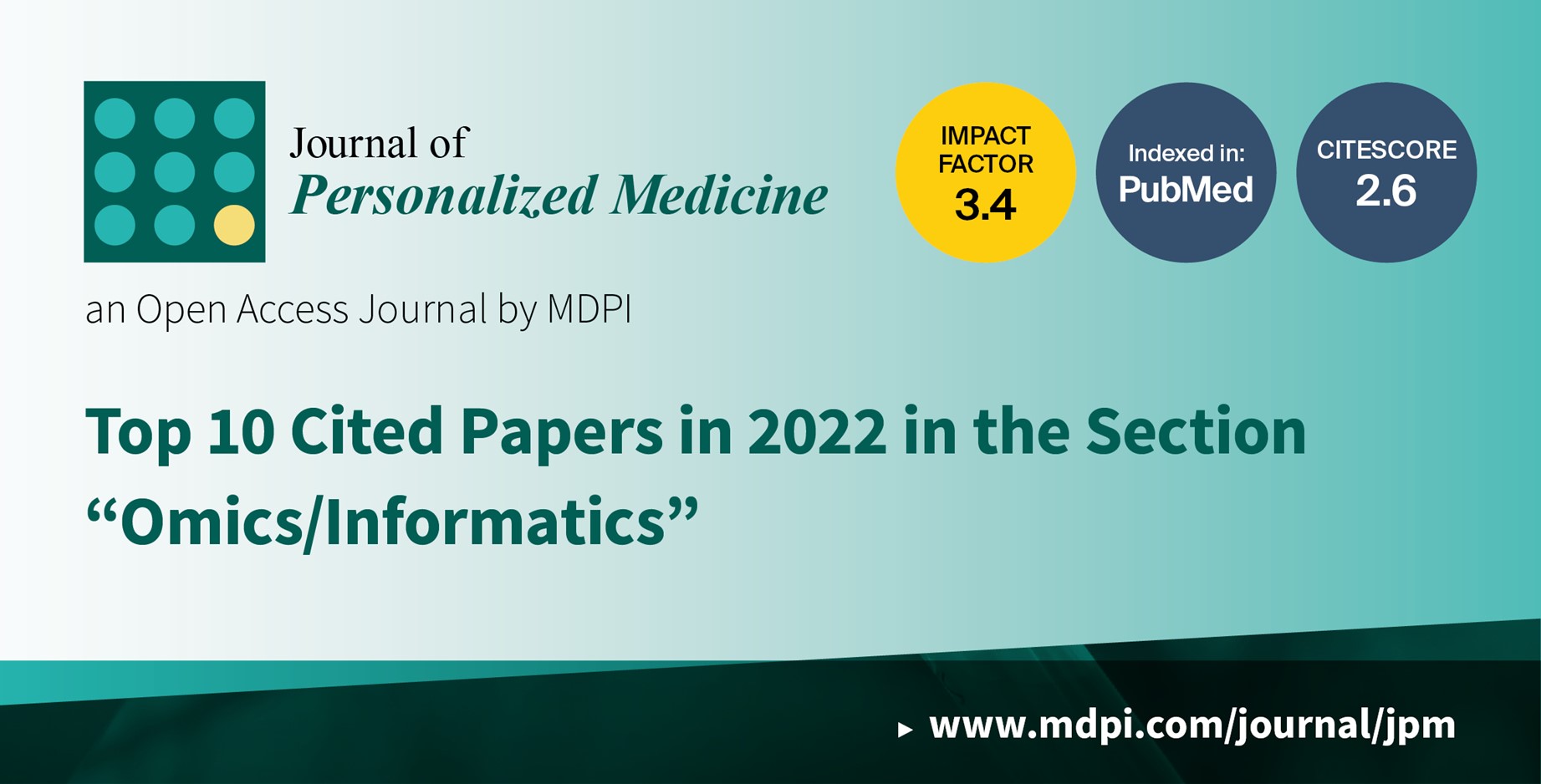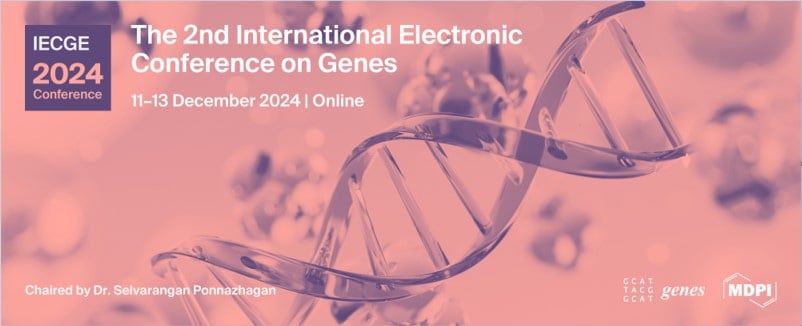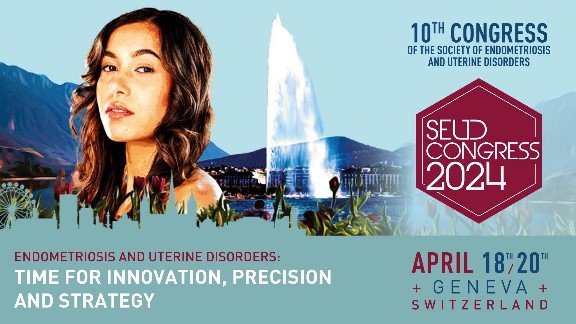-
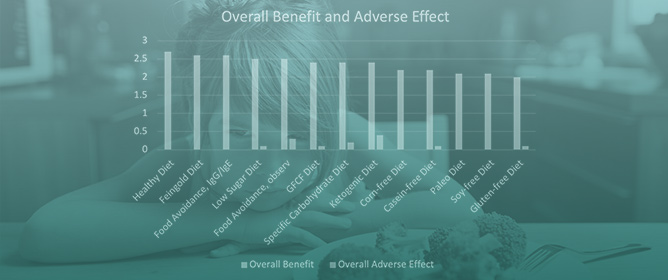 Ratings of the Effectiveness of 13 Therapeutic Diets for Autism Spectrum Disorder: Results of a National Survey
Ratings of the Effectiveness of 13 Therapeutic Diets for Autism Spectrum Disorder: Results of a National Survey -
 Cutaneous Manifestations of Rheumatoid Arthritis: Diagnosis and Treatment
Cutaneous Manifestations of Rheumatoid Arthritis: Diagnosis and Treatment -
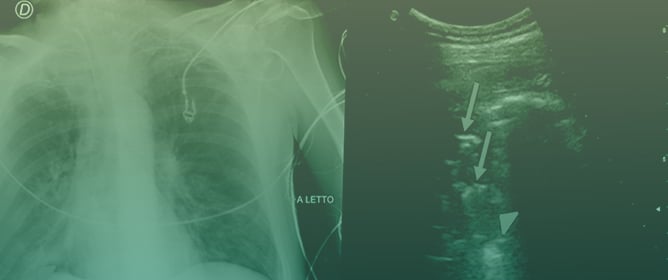 Point-of-Care Lung Ultrasound in Intensive Care Unit. The Dark Side of Radiologist. Where Do We Stand?
Point-of-Care Lung Ultrasound in Intensive Care Unit. The Dark Side of Radiologist. Where Do We Stand? -
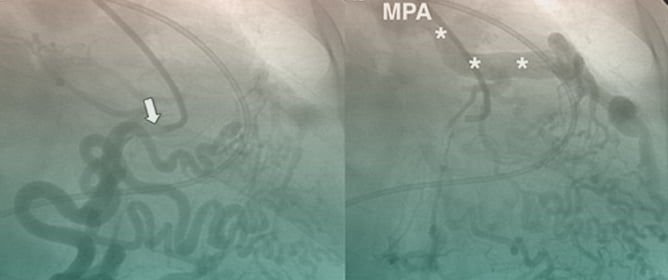 Anomalous Left Coronary Artery from the Pulmonary Artery: How to Diagnose and Treat
Anomalous Left Coronary Artery from the Pulmonary Artery: How to Diagnose and Treat -
 Glycyrrhizinic Acid as an Antiviral and Anticancer Agent in the Treatment of Human Papillomavirus
Glycyrrhizinic Acid as an Antiviral and Anticancer Agent in the Treatment of Human Papillomavirus
Journal Description
Journal of Personalized Medicine
Journal of Personalized Medicine
is an international, peer-reviewed, open access journal on personalized medicine, published monthly online by MDPI.
- Open Access— free for readers, with article processing charges (APC) paid by authors or their institutions.
- High Visibility: indexed within Scopus, SCIE (Web of Science), PubMed, PMC, Embase, and other databases.
- Journal Rank: JCR - Q2 (Medicine, General & Internal) CiteScore - Q2 (Medicine (miscellaneous))
- Rapid Publication: manuscripts are peer-reviewed and a first decision is provided to authors approximately 17.8 days after submission; acceptance to publication is undertaken in 2.6 days (median values for papers published in this journal in the second half of 2023).
- Recognition of Reviewers: reviewers who provide timely, thorough peer-review reports receive vouchers entitling them to a discount on the APC of their next publication in any MDPI journal, in appreciation of the work done.
Impact Factor:
3.4 (2022);
5-Year Impact Factor:
3.5 (2022)
Latest Articles
Geriatric Importance of Histopathological Parameters Evaluated in Thyroidectomy Specimens: A Single Center Retrospective Analysis
J. Pers. Med. 2024, 14(1), 95; https://doi.org/10.3390/jpm14010095 - 15 Jan 2024
Abstract
Nowadays, the aging human population exerts a notable influence on the treatment of thyroid diseases. The most appropriate approach for the treatment of benign and malignant thyroid diseases in older adults has not yet been determined. The aim of our study is to
[...] Read more.
Nowadays, the aging human population exerts a notable influence on the treatment of thyroid diseases. The most appropriate approach for the treatment of benign and malignant thyroid diseases in older adults has not yet been determined. The aim of our study is to evaluate the effect of thyroidectomies in geriatric patients considering age, sex and histopathological parameters and to determine the importance of thyroidectomy as a treatment option in the geriatric population. A total of 910 cases from all age groups were included, for which thyroidectomies were examined and reported. In accordance with the College of American Pathologists Cancer Protocol for thyroid reporting, considering geriatric patients, the rate of Thyroid Follicular Nodular Disease was significantly higher among the tumor types in the benign tumor group (p = 0.033), while Anaplastic Thyroid Carcinoma rate was higher in the malignant tumor group. The diagnosis rate of malignant tumors was higher in males, reflecting a more advanced pT stage (p < 0.001), larger tumor size (p < 0.001) and increased lymph node involvement rate (p = 0.039). Given that increasing age is associated with a heightened incidence of thyroid disease, the safety of surgery for geriatric patients is an important issue. Thyroidectomy should be considered in the treatment of these patients, especially in males, as the rate of malignant diagnosis and worse histopathological parameters are seen with increasing age.
Full article
(This article belongs to the Special Issue New Insight into Aging and Geriatric Syndromes: Clinical Updates and Perspectives)
►
Show Figures
Open AccessArticle
DeepBiomarker2: Prediction of Alcohol and Substance Use Disorder Risk in Post-Traumatic Stress Disorder Patients Using Electronic Medical Records and Multiple Social Determinants of Health
by
, , , , , , , and
J. Pers. Med. 2024, 14(1), 94; https://doi.org/10.3390/jpm14010094 - 14 Jan 2024
Abstract
Prediction of high-risk events amongst patients with mental disorders is critical for personalized interventions. We developed DeepBiomarker2 by leveraging deep learning and natural language processing to analyze lab tests, medication use, diagnosis, social determinants of health (SDoH) parameters, and psychotherapy for outcome prediction.
[...] Read more.
Prediction of high-risk events amongst patients with mental disorders is critical for personalized interventions. We developed DeepBiomarker2 by leveraging deep learning and natural language processing to analyze lab tests, medication use, diagnosis, social determinants of health (SDoH) parameters, and psychotherapy for outcome prediction. To increase the model’s interpretability, we further refined our contribution analysis to identify key features by scaling with a factor from a reference feature. We applied DeepBiomarker2 to analyze the EMR data of 38,807 patients from the University of Pittsburgh Medical Center diagnosed with post-traumatic stress disorder (PTSD) to determine their risk of developing alcohol and substance use disorder (ASUD). DeepBiomarker2 predicted whether a PTSD patient would have a diagnosis of ASUD within the following 3 months with an average c-statistic (receiver operating characteristic AUC) of 0.93 and average F1 score, precision, and recall of 0.880, 0.895, and 0.866 in the test sets, respectively. Our study found that the medications clindamycin, enalapril, penicillin, valacyclovir, Xarelto/rivaroxaban, moxifloxacin, and atropine and the SDoH parameters access to psychotherapy, living in zip codes with a high normalized vegetative index, Gini index, and low-income segregation may have potential to reduce the risk of ASUDs in PTSD. In conclusion, the integration of SDoH information, coupled with the refined feature contribution analysis, empowers DeepBiomarker2 to accurately predict ASUD risk. Moreover, the model can further identify potential indicators of increased risk along with medications with beneficial effects.
Full article
(This article belongs to the Section Methodology, Drug and Device Discovery)
►▼
Show Figures
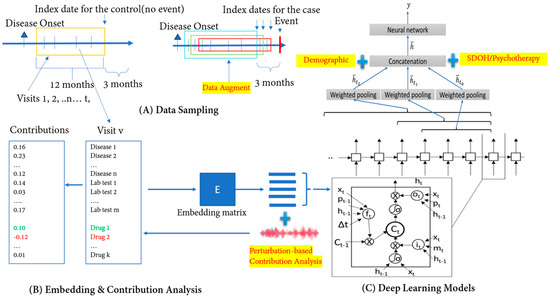
Figure 1
Open AccessReview
Laboratory Tools to Predict CFTR Modulator Therapy Effectiveness and to Monitor Disease Severity in Cystic Fibrosis
J. Pers. Med. 2024, 14(1), 93; https://doi.org/10.3390/jpm14010093 - 13 Jan 2024
Abstract
The implementation of cystic fibrosis (CF) transmembrane conductance regulator (CFTR) modulator drugs into clinical practice has been attaining remarkable therapeutic outcomes for CF, a life-threatening autosomal recessive genetic disease. However, there is elevated CFTR allelic heterogeneity, and various individuals carrying (ultra)rare CF genotypes
[...] Read more.
The implementation of cystic fibrosis (CF) transmembrane conductance regulator (CFTR) modulator drugs into clinical practice has been attaining remarkable therapeutic outcomes for CF, a life-threatening autosomal recessive genetic disease. However, there is elevated CFTR allelic heterogeneity, and various individuals carrying (ultra)rare CF genotypes remain without any approved modulator therapy. Novel translational model systems based on individuals’ own cells/tissue are now available and can be used to interrogate in vitro CFTR modulator responses and establish correlations of these assessments with clinical features, aiming to provide prediction of therapeutic effectiveness. Furthermore, because CF is a progressive disease, assessment of biomarkers in routine care is fundamental in monitoring treatment effectiveness and disease severity. In the first part of this review, we aimed to focus on the utility of individual-derived in vitro models (such as bronchial/nasal epithelial cells and airway/intestinal organoids) to identify potential responders and expand personalized CF care. Thereafter, we discussed the usage of CF inflammatory biomarkers derived from blood, bronchoalveolar lavage fluid, and sputum to routinely monitor treatment effectiveness and disease progression. Finally, we summarized the progress in investigating extracellular vesicles as a robust and reliable source of biomarkers and the identification of microRNAs related to CFTR regulation and CF inflammation as novel biomarkers, which may provide valuable information for disease prognosis.
Full article
(This article belongs to the Section Pharmacogenetics)
►▼
Show Figures

Graphical abstract
Open AccessArticle
Kidney Biopsy and Immuno-Rheumatological Diseases: A Retrospective and Observational Study
by
, , , , , , , , , , and
J. Pers. Med. 2024, 14(1), 92; https://doi.org/10.3390/jpm14010092 - 13 Jan 2024
Abstract
Renal involvement is a common occurrence in patients with immuno-rheumatological diseases (IRDs). Several instances of glomerulonephritis (GN) occur in the setting of IRD and complicate the clinical course of an underlying condition. The aim of this study was to observe the spectrum of
[...] Read more.
Renal involvement is a common occurrence in patients with immuno-rheumatological diseases (IRDs). Several instances of glomerulonephritis (GN) occur in the setting of IRD and complicate the clinical course of an underlying condition. The aim of this study was to observe the spectrum of nephropathies according to age, kidney function, history of IRD at the time of biopsy, and histopathological kidney diagnosis. We evaluated data relating to 699 consecutive kidney native biopsies (female 52.1%) with a median age of 48 years (IQR 34–62) performed in adult patients collected over 15 years. The study population was divided into three groups: patients with kidney histological findings correlated to underlying IRD (Group 1), patients with kidney histological findings not correlated to underlying IRD (Group 2), and patients with kidney histological findings compatible with “de novo” IRD (absent in personal medical history) (Group 3). Kidney involvement related to IRD was found in 25.2% of patients. Group 1 was mostly represented by lupus nephritis (76.6%), with a younger age than Group 3 (p < 0.001) and by a higher percentage of females than other groups (p < 0.001). Group 3 was the most represented by microscopic polyangiitis (50.8%) when compared with the other two groups (p < 0.001). Acute nephritic syndrome (p < 0.001), acute kidney injury (AKI), and abnormal urinalysis (p < 0.001) were more represented in Group 3 than the other groups. In conclusion, IRDs are characterized by different clinical presentations and heterogeneous histological findings. Kidney biopsy remains fundamental to achieving the correct diagnosis and starting targeted therapy.
Full article
(This article belongs to the Section Disease Biomarker)
►▼
Show Figures
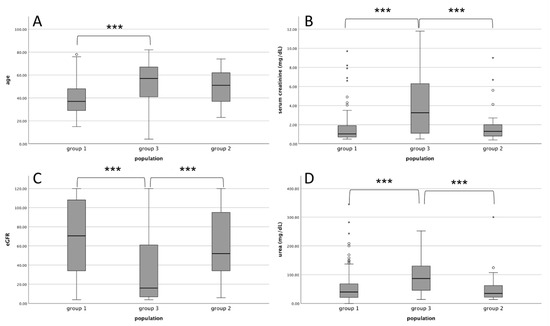
Figure 1
Open AccessSystematic Review
Sex Bias in Diagnostic Delay: Are Axial Spondyloarthritis and Ankylosing Spondylitis Still Phantom Diseases in Women? A Systematic Review and Meta-Analysis
J. Pers. Med. 2024, 14(1), 91; https://doi.org/10.3390/jpm14010091 - 13 Jan 2024
Abstract
Diagnostic delay (DD) is associated with poor radiological and quality of life outcomes in axial spondyloarthritis (ax-SpA) and ankylosing spondylitis (AS). The female (F) population is often misdiagnosed, as classification criteria were previously studied mostly in males (M). We conducted a systematic review
[...] Read more.
Diagnostic delay (DD) is associated with poor radiological and quality of life outcomes in axial spondyloarthritis (ax-SpA) and ankylosing spondylitis (AS). The female (F) population is often misdiagnosed, as classification criteria were previously studied mostly in males (M). We conducted a systematic review to investigate (i) the difference in DD between the sexes, the impact of HLA*B27 and clinical and social factors (work and education) on this gap, and (ii) the possible influence of the year of publication (before and after the 2009 ASAS classification criteria), geographical region (Europe and Israel vs. extra-European countries), sample sources (mono-center vs. multi-center studies), and world bank (WB) economic class on DD in both sexes. We searched, in PubMed and Embase, studies that reported the mean or median DD or the statistical difference in DD between sexes, adding a manual search. Starting from 399 publications, we selected 26 studies (17 from PubMed and Embase, 9 from manual search) that were successively evaluated with the modified Newcastle–Ottawa Scale (m-NOS). The mean DD of 16 high-quality (m-NOS > 4/8) studies, pooled with random-effects meta-analysis, produces results higher in F (1.48, 95% CI 0.83–2.14, p < 0.0001) but with significant results at the second analysis only in articles published before the 2009 ASAS classification criteria (0.95, 95% CI 0.05–1.85, p < 0.0001) and in extra-European countries (3.16, 95% CI 2.11–4.22, p < 0.05). With limited evidence, some studies suggest that DD in F might be positively influenced by HLA*B27 positivity, peripheral involvement, and social factors.
Full article
(This article belongs to the Section Sex, Gender and Hormone Based Medicine)
►▼
Show Figures
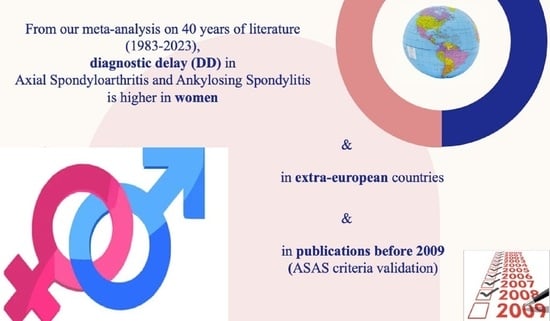
Graphical abstract
Open AccessArticle
The Validation of the Speech, Spatial and Qualities of Hearing Scale SSQ12 for Native Romanian Speakers with and without Hearing Impairment
by
, , , , and
J. Pers. Med. 2024, 14(1), 90; https://doi.org/10.3390/jpm14010090 - 13 Jan 2024
Abstract
Background: The perceived impact of hearing loss varies considerably among those affected due to the heterogeneous types of hearing loss, their diverse etiologies, and the different rehabilitation possibilities. Therefore, assessing listening skills in a daily context using questionnaires is essential. This study aimed
[...] Read more.
Background: The perceived impact of hearing loss varies considerably among those affected due to the heterogeneous types of hearing loss, their diverse etiologies, and the different rehabilitation possibilities. Therefore, assessing listening skills in a daily context using questionnaires is essential. This study aimed to investigate the validity and reliability of the adapted version of the Speech, Spatial and Qualities of Hearing Scale 12 (SSQ12) in the Romanian language. Materials and Methods: The SSQ12 is a 12-item self-reporting questionnaire that assesses a range of everyday listening situations. The internal consistency, test–retest reliability, and validity of the r-SSQ12 questionnaire resulting from the adaptation of the original scale were investigated. Results: The responses of 183 subjects aged between 11 and 79 years were evaluated. In total, 121 subjects had hearing loss (19 adolescents), and 62 subjects had normal hearing (11 adolescents). Significant differences were observed in the means of the overall score and for individual items between normal-hearing subjects and subjects with hearing loss. The SSQ12 had high internal consistency (Cronbach’s alpha = 0.97), and the test–retest scores were highly correlated. Conclusions: The SSQ12 scale can be used to investigate the self-reporting of hearing quality in both general populations to identify hearing disorders and populations with hearing loss.
Full article
(This article belongs to the Special Issue Personalized Medicine in Otolaryngology: Special Topic Otology)
►▼
Show Figures
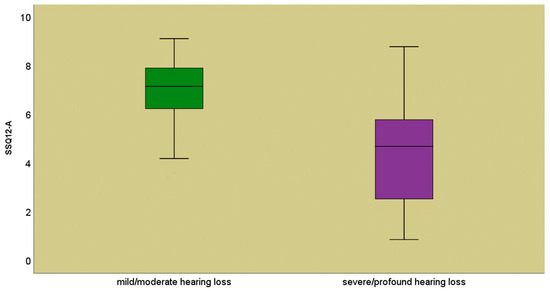
Figure 1
Open AccessArticle
Association between Relative Thrombocytosis and Microalbuminuria in Adults with Mild Fasting Hyperglycemia
J. Pers. Med. 2024, 14(1), 89; https://doi.org/10.3390/jpm14010089 - 12 Jan 2024
Abstract
An elevated platelet count may contribute to significant thrombotic events and pose a risk for diabetic microvascular complications. Albuminuria, one of the hallmarks of diabetes, is thought to be a risk factor for endothelial dysfunction. In this study, we investigated the association between
[...] Read more.
An elevated platelet count may contribute to significant thrombotic events and pose a risk for diabetic microvascular complications. Albuminuria, one of the hallmarks of diabetes, is thought to be a risk factor for endothelial dysfunction. In this study, we investigated the association between relative thrombocytosis and an increased urine albumin-to-creatinine ratio in healthy adult participants. Using multivariate analyses on data from the Korea National Health and Nutrition Examination Survey V–VI, 12,525 eligible native Koreans aged ≥ 20 were categorized into platelet count quintiles by sex. The highest platelet count quintile included younger, more obese participants with elevated white blood cell counts, poor lipid profiles, and a better estimated glomerular filtration rate. Restricted cubic spline regression analysis revealed significant associations between platelet count and fasting blood glucose, glycated hemoglobin, and urine albumin-to-creatinine ratio. Adjusted logistic regression models indicated that heightened fasting blood glucose and platelet count were linked to risk of microalbuminuria (fasting blood glucose, odds ratio = 1.026, 95%CI = 1.011–1.042; platelet count, odds ratio = 1.004, 95%CI = 1.002–1.006). Particularly, an increased platelet count was notably associated with microalbuminuria progression in subjects with impaired fasting glucose. These findings suggest that an elevated platelet count, even below diagnostic thrombocytosis levels, independently correlates with an increased risk of vascular endothelial dysfunction in patients with impaired fasting glucose.
Full article
(This article belongs to the Topic Public Health and Healthcare in the Context of Big Data)
►▼
Show Figures
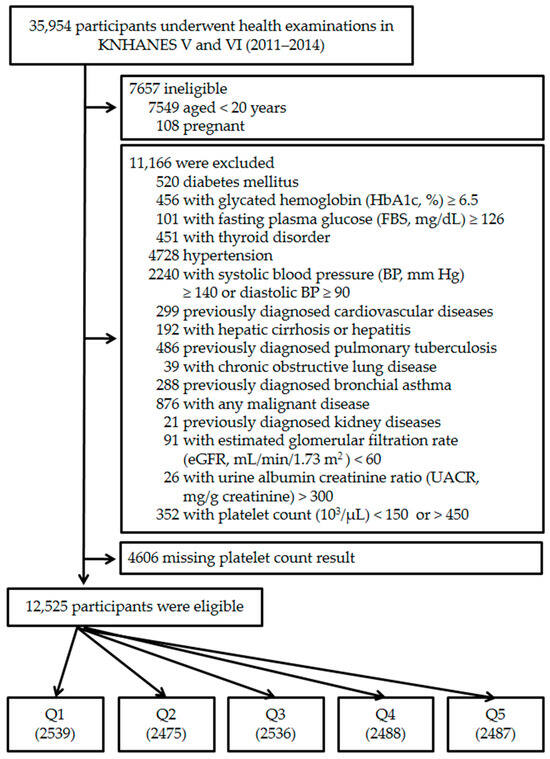
Figure 1
Open AccessArticle
Supervised Pelvic Floor Muscle Training Improves Sexual Function and Diminishes Sexual Distress in Women with Relapsing–Remitting Multiple Sclerosis: A Randomised Controlled Study
by
, , , , , , , , , , , and
J. Pers. Med. 2024, 14(1), 88; https://doi.org/10.3390/jpm14010088 - 12 Jan 2024
Abstract
This study investigates the impact of pelvic floor muscle training (PFMT) on sexual function and distress in women with multiple sclerosis (MS), a prevalent chronic nervous system disorder associated with sexual dysfunction. This study’s primary aim was to assess the effectiveness of PFMT
[...] Read more.
This study investigates the impact of pelvic floor muscle training (PFMT) on sexual function and distress in women with multiple sclerosis (MS), a prevalent chronic nervous system disorder associated with sexual dysfunction. This study’s primary aim was to assess the effectiveness of PFMT at improving sexual function and alleviating sexual distress in this population. In a randomised controlled trial, 82 women with MS were divided into two groups: Group A (41 women) underwent 12 weeks of PFMT, while Group B (41 women) served as a control group with no intervention. Both groups were assessed at the beginning and end of this study using the Female Sexual Function Index (FSFI) and Female Sexual Distress Scale-Revised (FSDS-R). Statistical analysis, including Chi-square tests, was employed to compare the outcomes between the two groups, with a p-value of less than 0.05 considered significant. The results revealed no significant differences in baseline sexual function and distress between the groups. However, at the conclusion of the 12-week period, Group A exhibited statistically significant improvements in nearly all domains of FSFI and FSDS-R compared to Group B, except in the pain domain. This study concludes that PFMT can effectively enhance sexual function and reduce sexual distress in women suffering from MS. These findings underscore the potential of PFMT as a therapeutic intervention in managing sexual dysfunction associated with MS.
Full article
(This article belongs to the Special Issue Clinical Development in Multiple Sclerosis Diagnosis and Treatment)
►▼
Show Figures
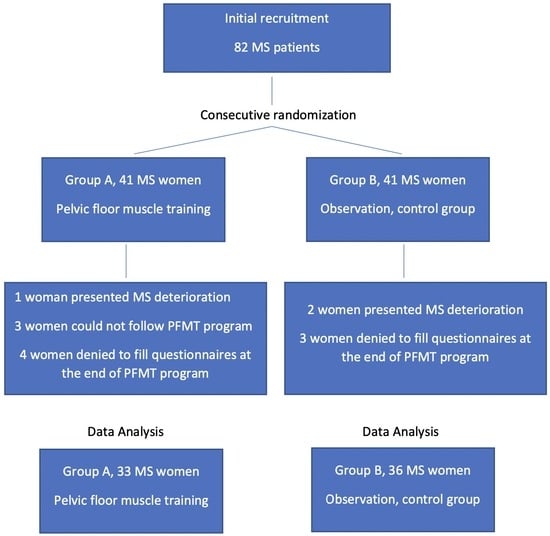
Graphical abstract
Open AccessArticle
Histopathological Clues of Enhanced Inflammation in the Placental Tissue of Women with Chronic Venous Disease in Lower Limbs during Pregnancy
by
, , , , , , , , , , , and
J. Pers. Med. 2024, 14(1), 87; https://doi.org/10.3390/jpm14010087 - 12 Jan 2024
Abstract
It is estimated that approximately one in three women develop chronic venous disease (CVD) during pregnancy, a broad spectrum of morphofunctional disorders affecting the venous system in different regions of the body, including the lower limbs. A growing body of evidence supports the
[...] Read more.
It is estimated that approximately one in three women develop chronic venous disease (CVD) during pregnancy, a broad spectrum of morphofunctional disorders affecting the venous system in different regions of the body, including the lower limbs. A growing body of evidence supports the diverse maternofetal consequences derived from this condition, with the placenta being an organ particularly affected. Among other consequences, having CVD during pregnancy has been associated with systemic inflammation and altered cytokines and chemokine profiles in the maternal and fetal serum related to this condition. In the present work, we aimed to analyze if these inflammatory changes also occurred in the placental tissue of women with CVD, exploring by immunohistochemistry and real-time PCR (RT-qPCR) gene and protein expression of critical inflammatory markers like allograft inflammatory factor 1 (AIF-1), interleukin 10 (IL-10), IL-12A, and IL-18. Our results demonstrate an enhanced tissue expression of AIF-1, IL-12A, and IL-18, accompanied by a decrease in IL-10 in the placentas of women who had undergone CVD during pregnancy. Overall, our results suggest a possible pathophysiological role of inflammation in the placental tissue of women with CVD during pregnancy, although the precise consequences of this feature remain to be deeply analyzed.
Full article
(This article belongs to the Special Issue Biomarkers for Inflammatory and Metabolic Disorders)
►▼
Show Figures
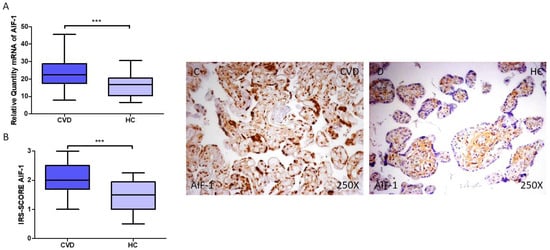
Figure 1
Open AccessCase Report
Immunotherapy Combined with Radiation in Malignant Melanoma without BRAF Mutations Brain Metastases—Favorable Response after Immunotherapy Continued beyond Progression
by
, , , , , , , , and
J. Pers. Med. 2024, 14(1), 86; https://doi.org/10.3390/jpm14010086 - 12 Jan 2024
Abstract
We present the case of a patient who was diagnosed in 2018 with nodular Malignant Melanoma (MM) without BRAF V 600 mutations stage 3 C (pT4b pN1a M0), and who underwent adjuvant citokines treatment with Interferon alpha 2b-48 weeks. Immunotherapy was initiated in
[...] Read more.
We present the case of a patient who was diagnosed in 2018 with nodular Malignant Melanoma (MM) without BRAF V 600 mutations stage 3 C (pT4b pN1a M0), and who underwent adjuvant citokines treatment with Interferon alpha 2b-48 weeks. Immunotherapy was initiated in January 2021 for lung and lymph node metastases. In June 2021, there was a partial response of the lung and lymph node metastases, but there was also progression to brain metastases. Immunotherapy was continued and Whole Brain Radiotherapy (WBRT) was performed. In September 2023, the imaging investigations revealed a favorable response, with no lesions suggestive of secondary determinations. The combination of Radiotherapy (RT) and Immunotherapy (IT) with Immune Checkpoint Inhibitors (ICI) has an abscopal effect. There is a coordinated action in the combination of RT and IT in order to obtain a common result, with the antitumor effect being greater than if RT or IT acted separately.
Full article
(This article belongs to the Section Personalized Therapy and Drug Delivery)
►▼
Show Figures

Figure 1
Open AccessFeature PaperArticle
Assessing the Efficacy of Laser Therapy and Autologous Platelet-Rich Plasma (PRP) Treatment for Chronic Wounds
by
, , , , , , , , and
J. Pers. Med. 2024, 14(1), 85; https://doi.org/10.3390/jpm14010085 - 11 Jan 2024
Abstract
(1) Background: The management of persistent wounds is a topic of significant concern, particularly when they become chronic. Clinicians are focused on reducing the healing duration of chronic wounds and employing the most efficient treatments. Successful wound management requires an understanding of standard
[...] Read more.
(1) Background: The management of persistent wounds is a topic of significant concern, particularly when they become chronic. Clinicians are focused on reducing the healing duration of chronic wounds and employing the most efficient treatments. Successful wound management requires an understanding of standard healing processes, the elements that can impede healing progress, and strategies to manage these impediments. (2) Methods: We participated in a study involving a cohort of 115 patients. Data were collected through subjective assessments via questionnaires, examining the comparative effects of laser therapy and platelet-rich plasma (PRP) on patients’ conditions and monitored the progression of chronic wounds. For the study, we utilized a branded laser equipped with a 12-watt probe to stimulate chronic wounds in 65 patients, while the PRP procedure was administered to 50 patients. (3) Results: We observed a greater improvement in local symptoms among the patients who received laser therapy compared to those in the PRP group. (4) Conclusions: We consider both therapies to be of significant importance due to their positive and beneficial effects, particularly on the symptomatology and progression of chronic wounds. Nevertheless, superior results were documented in patients who underwent laser therapy.
Full article
(This article belongs to the Special Issue Implications for Personalized Plastic, Aesthetic and Reconstructive Surgery)
►▼
Show Figures

Figure 1
Open AccessSystematic Review
Health Policy for Prostate Cancer Early Detection in the European Union and the Impact of Opportunistic Screening: PRAISE-U Consortium
J. Pers. Med. 2024, 14(1), 84; https://doi.org/10.3390/jpm14010084 - 11 Jan 2024
Abstract
With the new policy recommendation in 2022 to explore the possibilities of screening for prostate cancer by the European Commission, the landscape for prostate cancer early detection is evolving. In line with this recommendation, the PRAISE-U project aims to evaluate the early detection
[...] Read more.
With the new policy recommendation in 2022 to explore the possibilities of screening for prostate cancer by the European Commission, the landscape for prostate cancer early detection is evolving. In line with this recommendation, the PRAISE-U project aims to evaluate the early detection and diagnosis of prostate cancer through customised and risk-based screening programmes, with the goal to align protocols across European Union member states. This systematic review is part of the PRAISE-U project, with the goal to review the policy, medical guideline recommendations, and the current level of opportunistic screening presented in the scientific literature on prostate cancer early detection from 2016 to 2023 in European Union member states. An extensive literature search was performed on 1 June 2023 in a large number of databases, including Embase.com, Medline (Ovid), Web of Science Core Collection, Google Scholar, and Policy Commons. We identified 318 articles (qualitative, quantitative, and reviews), of which 41 were included in the full-text screening. Seventeen articles were ultimately identified as eligible for inclusion. The included articles revealed significant variations towards PSA-based early detection policies for prostate cancer in nine European countries. Despite official recommendations, opportunistic screening was prevalent across all nine countries regardless of recommendations for or against PSA-based early detection. This systematic review suggests that the current early detection policies are not fit for purpose. High levels of opportunistic screening and overdiagnosis persist, prompting policy recommendations for standardised guidelines, informed decision making, and increased awareness to improve efficiency and effectiveness in early detection.
Full article
(This article belongs to the Section Epidemiology)
►▼
Show Figures

Figure 1
Open AccessArticle
Effects of Adding Extracorporeal Shockwave Therapy (ESWT) to Platelet-Rich Plasma (PRP) among Patients with Rotator Cuff Partial Tear: A Prospective Randomized Comparative Study
by
, , , , , , , , , , , , and
J. Pers. Med. 2024, 14(1), 83; https://doi.org/10.3390/jpm14010083 - 10 Jan 2024
Abstract
A rotator cuff tear is a prevalent ailment affecting the shoulder joint. The clinical efficacy of combined therapy remains uncertain for partial rotator cuff tears. In this study, we integrated extracorporeal shockwave therapy (ESWT) with platelet-rich plasma (PRP) injection, juxtaposed with PRP in
[...] Read more.
A rotator cuff tear is a prevalent ailment affecting the shoulder joint. The clinical efficacy of combined therapy remains uncertain for partial rotator cuff tears. In this study, we integrated extracorporeal shockwave therapy (ESWT) with platelet-rich plasma (PRP) injection, juxtaposed with PRP in isolation. Both cohorts exhibited significant improvements in visual analogue scale (VAS), Constant–Murley score (CMS), degrees of forward flexion, abduction, internal rotation, and external rotation, and the sum of range of motion (SROM) over the six-month assessment period. The application of ESWT in conjunction with PRP exhibited notable additional enhancements in both forward flexion (p = 0.033) and abduction (p = 0.015) after one month. Furthermore, a substantial augmentation in the range of shoulder motion (SROM) (p < 0.001) was observed after six months. We employed isobaric tag for relative and absolute quantitation (iTRAQ) to analyze the differential plasma protein expression in serum samples procured from the two groups after one month. The concentrations of S100A8 (p = 0.042) and S100A9 (p = 0.034), known to modulate local inflammation, were both lower in the ESWT + PRP cohort. These findings not only underscore the advantages of combined therapy but also illuminate the associated molecular changes.
Full article
(This article belongs to the Section Clinical Medicine, Cell, and Organism Physiology)
►▼
Show Figures
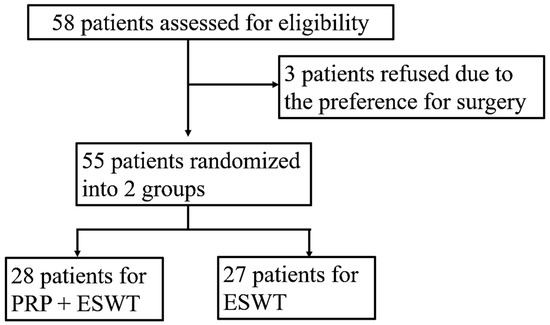
Figure 1
Open AccessArticle
A Multidisciplinary Skull Base Board for Tumour and Non-Tumour Diseases: Initial Experiences
by
, , , , , , and
J. Pers. Med. 2024, 14(1), 82; https://doi.org/10.3390/jpm14010082 - 10 Jan 2024
Abstract
The skull base is the area where various cancerous and non-cancerous diseases occur and represents the intersection of several medical fields. The key is an integrated treatment by specialists of multiple disciplines. We prospectively analysed patients with a skull base disease between August
[...] Read more.
The skull base is the area where various cancerous and non-cancerous diseases occur and represents the intersection of several medical fields. The key is an integrated treatment by specialists of multiple disciplines. We prospectively analysed patients with a skull base disease between August 2022 and 2023 and presented to the Multidisciplinary Skull Base Board (MDT-SB), which takes place once a month hybridly (in-person and remotely). Thirty-nine patients (median age of 58.2 years) were included, of which twelve (30.8%) had a benign tumour, twelve (30.8%) had a malignant tumour, five had an infection (12.8%), and ten (25.6%) had other diseases. For each patient, at least two otorhinolaryngologists, a neurosurgeon, and a neuroradiologist, as well as an infectious disease specialist, a paediatrician, an oculoplastic surgeon, a maxillofacial surgeon, and a pathologist were involved in 10%, 8%, 8%, 3%, and 3% of cases, respectively. In fifteen patients (38%), the MDT-SB suggested surgical treatment; in fourteen (36%), radiological follow-ups; in five (13%), non-surgical treatments; in two, conservative treatments (5%); in two (5%), surgical and conservative treatments; and in one (3%), a biopsy. Non-cancerous and cancerous diseases of the skull base in adults and children should be presented to the MDT-SB, which consists of at least an otolaryngologist, a neurosurgeon, and a neuroradiologist.
Full article
(This article belongs to the Section Personalized Therapy and Drug Delivery)
Open AccessSystematic Review
Systematic Review of Current Audiological Treatment Options for Patients with Treacher Collins Syndrome (TCS) and Surgical and Audiological Experiences of an Otorhinolaryngologist with TCS
J. Pers. Med. 2024, 14(1), 81; https://doi.org/10.3390/jpm14010081 - 10 Jan 2024
Abstract
Treacher Collins syndrome (TCS) is a rare congenital craniofacial condition that affects approximately one out of fifty thousand births. Different ratios of TCS patients have conductive hearing loss: 88%1 vs. 91.4–100.00%2. For this reason, it was examined which hearing solutions
[...] Read more.
Treacher Collins syndrome (TCS) is a rare congenital craniofacial condition that affects approximately one out of fifty thousand births. Different ratios of TCS patients have conductive hearing loss: 88%1 vs. 91.4–100.00%2. For this reason, it was examined which hearing solutions can be used with this condition and how effective they are. A systematic literature review was conducted, which showed that the bone-anchored hearing aid (BAHA, OSIA), the bone conduction implant (Bonebridge) or the active implant of the middle ear (Soundbridge) are reliable methods for the treatment of conductive hearing loss in TCS patients. After the implantation of all available hearing solutions, improved hearing and speech comprehension were observed. Additionally, a statement regarding the treatment of TCS and a personalized point of view of a clinical expert with TCS were provided. However, due to the small amount of data, no general recommendations can be given for the treatment of hearing loss in TCS patients; therefore, it is advised to collect more data on hearing solutions for TCS patients in future research.
Full article
(This article belongs to the Special Issue Personalized Medicine in Otolaryngology: Special Topic Otology)
►▼
Show Figures
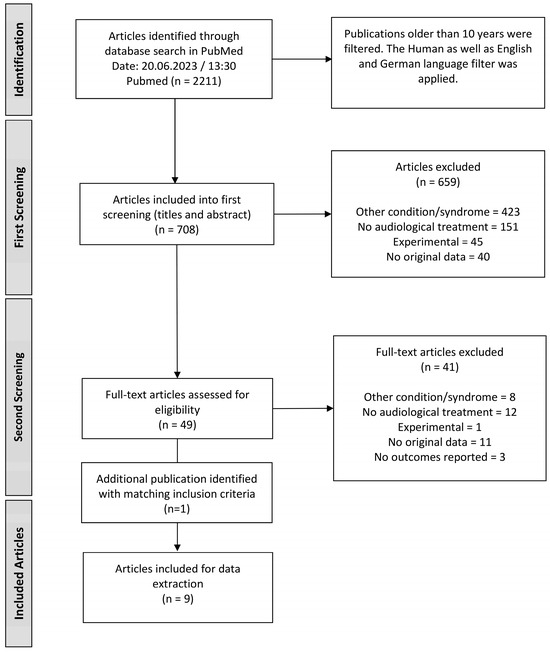
Figure 1
Open AccessArticle
Predicting Short- and Long-Term Functional Outcomes Based on Serum S100B Protein Levels in Patients with Ischemic Stroke
by
, , , , , , , and
J. Pers. Med. 2024, 14(1), 80; https://doi.org/10.3390/jpm14010080 - 10 Jan 2024
Abstract
Background: Ischemic stroke is one of the leading causes of mortality and disability. The neuroimaging methods are the gold standard for diagnostics. Biomarkers of cerebral ischemia are considered to be potentially helpful in the determination of the etiology and prognosis of patients with
[...] Read more.
Background: Ischemic stroke is one of the leading causes of mortality and disability. The neuroimaging methods are the gold standard for diagnostics. Biomarkers of cerebral ischemia are considered to be potentially helpful in the determination of the etiology and prognosis of patients with ischemic stroke. Aim: This study aimed to investigate the usefulness of serum S100B protein levels as a short- and long-term prognostic factor in patients with ischemic stroke. Study design and methods: The study group comprised 65 patients with ischemic stroke. S100B protein levels were measured by immunoenzymatic assay. Short-term functional outcome was determined by the NIHSS score on day 1 and the difference in the NIHSS scores between day 1 and day 9 (delta NIHSS). Long-term outcome was assessed by the modified Rankin Scale (MRS) at 3 months after the stroke. At the end of the study, patients were divided into groups based on the NIHSS score on day 9 (0–8 “good” and >8 “poor”), the delta NIHSS (“no improvement” ≤0 and >0 “improvement”), and the MRS (“good” 0–2 and >2 “poor”). Differences in S100B levels between groups were analyzed with the ROC curve to establish the optimal cut-off point for S100B. The odds ratio was calculated to determine the strength of association. Correlations between S100B levels at three time points and these variables were evaluated. Results: We revealed a statistically significant correlation between S100B levels at each measurement point (<24 h, 24–48 H, 48–72 h) and the NIHSS score on day 9 (R Spearman 0.534, 0.631, and 0.517, respectively) and the MRS score after 3 months (R Spearman 0.620, 0.657, and 0.617, respectively). No statistically significant correlation was found between S100B levels and the delta NIHSS. Analysis of the ROC curve confirmed a high sensitivity and specificity for S100B. The calculated AUC for the NIHSS on day 9 were 90.2%, 95.0%, and 82.2%, respectively, and for the MRS, 83.5%, 83.4%, and 84.0%, respectively. After determining the S100B cut-off, the odds ratio for beneficial effect (NIHSS ≤ 8 at day 9 or MRS 0–2 after 3 months) was determined for each sampling point. Conclusion: S100B is a useful marker for predicting short- and long-term functional outcomes in patients with ischemic stroke.
Full article
(This article belongs to the Special Issue Emergency Medicine: Clinical Advances and Challenges in Diagnosis and Treatment)
►▼
Show Figures
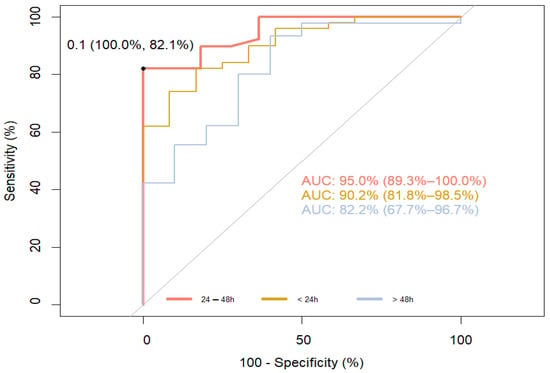
Figure 1
Open AccessReview
Progesterone Hypersensitivity in Assisted Reproductive Technologies: Implications for Safety and Efficacy
by
, , , and
J. Pers. Med. 2024, 14(1), 79; https://doi.org/10.3390/jpm14010079 - 10 Jan 2024
Abstract
The global rise in the age of childbirth, influenced by changing sociodemographic patterns, has had a notable impact on fertility rates. Simultaneously, assisted reproductive techniques (ARTs) have become increasingly prevalent due to advancements in reproductive medicine. The paper explores the intersection between the
[...] Read more.
The global rise in the age of childbirth, influenced by changing sociodemographic patterns, has had a notable impact on fertility rates. Simultaneously, assisted reproductive techniques (ARTs) have become increasingly prevalent due to advancements in reproductive medicine. The paper explores the intersection between the surge in ARTs and the rising number of iatrogenic autoimmune progesterone dermatitis (APD). Autoimmune progesterone dermatitis, commonly known as progesterone hypersensitivity, manifests itself as a mucocutaneous hypersensitivity syndrome. It is characterized by a wide range of dermatological symptoms, with urticaria and maculopapular rashes being the most prominent signs. Concurrently, systemic symptoms, such as fever, angioedema, and, in severe instances, anaphylaxis, may ensue. This dermatologic condition poses a significant challenge to women of childbearing age. This intricate syndrome frequently manifests itself in conjunction with menstruation or pregnancy as a reaction to physiological fluctuations in endogenous progesterone. However, given that exposure to exogenous progesterone is an integral component of various modern therapies, secondary APD has also been described. Our findings unveil a heightened likelihood of developing secondary progesterone hypersensitivity in ART patients that is attributed to the administration of exogenous progesterone through intramuscular, intravaginal, and oral routes. The study also explores available therapeutic interventions for facilitating viable pregnancies in individuals grappling with autoimmune progesterone dermatitis within the context of ARTs. This comprehensive analysis contributes valuable insights into the intricate relationship between reproductive technologies, dermatological challenges, and successful pregnancy outcomes.
Full article
(This article belongs to the Special Issue Interdisciplinary Approach and Personalized Therapy for Gynecological Disease)
Open AccessArticle
Multi-Omics Reveals the Role of Osteopontin/Secreted Phosphoprotein 1 in Regulating Ovarian Aging
by
, , , , , and
J. Pers. Med. 2024, 14(1), 78; https://doi.org/10.3390/jpm14010078 - 09 Jan 2024
Abstract
Secreted phosphoprotein 1 (SPP1), also known as osteopontin (OPN), is located on chromosome 4q22.1. This multifunctional secreted acidic glycoprotein is expressed intracellularly and extracellularly in various tissues, where it interacts with regulatory proteins and pro-inflammatory immune chemokines, contributing to the pathogenesis of multiple
[...] Read more.
Secreted phosphoprotein 1 (SPP1), also known as osteopontin (OPN), is located on chromosome 4q22.1. This multifunctional secreted acidic glycoprotein is expressed intracellularly and extracellularly in various tissues, where it interacts with regulatory proteins and pro-inflammatory immune chemokines, contributing to the pathogenesis of multiple diseases. Nevertheless, the intricate genetic connections between SPP1 and ovarian aging remain largely unexplored. This study aims to bridge this knowledge gap by delving into ovarian aging and its associations with SPP1 using multi-omics data analysis. Our findings indicate that SPP1 is a potential gene related to ovarian aging. To comprehend the role of SPP1, we conducted spatial transcriptomic analyses on young and aged female mouse ovaries, revealing a significant decline in SPP1 expression in the aging group compared to the young group. Similarly, a significantly low level of SPP1 was found in the 73-year-old sample. Additionally, in-depth single-cell RNA-sequencing analysis identified associations between SPP1 and ITGAV, ITGB1, CD44, MMP3, and FN1. Notably, co-expression analysis highlighted a strong correlation between SPP1 and ITGB1. In summary, this study pioneers the identification of SPP1 as a gene implicated in ovarian aging. Further research into the role of SPP1 has the potential to advance precision medicine and improve treatment strategies for ovarian aging-related conditions.
Full article
(This article belongs to the Special Issue Bioinformatics and Medicine)
►▼
Show Figures

Figure 1
Open AccessEditorial
Paediatric Neurology: Current Trends, Rehabilitation, and Future Challenges
by
and
J. Pers. Med. 2024, 14(1), 77; https://doi.org/10.3390/jpm14010077 - 09 Jan 2024
Abstract
Over the past 20 years, the introduction of new neurodevelopmental assessments and neurophysiological techniques has improved the knowledge of the complexity of the central nervous system in the first period of development [...]
Full article
(This article belongs to the Special Issue Pediatric Neurology: Current Trends, Rehabilitation and Future Challenges)
Open AccessReview
Vulvar Lichen Sclerosus: Navigating Sex Hormone Dynamics and Pioneering Personalized Treatment Paradigm
J. Pers. Med. 2024, 14(1), 76; https://doi.org/10.3390/jpm14010076 - 08 Jan 2024
Abstract
Vulvar lichen sclerosus (VLS) is a frequently overlooked inflammatory disorder affecting the skin and mucous membranes of the vulva. With a propensity for atrophy, severe scarring, functional impairment, and malignant evolution, VLS is a disease that recurs frequently; early diagnosis, rapid treatment, and
[...] Read more.
Vulvar lichen sclerosus (VLS) is a frequently overlooked inflammatory disorder affecting the skin and mucous membranes of the vulva. With a propensity for atrophy, severe scarring, functional impairment, and malignant evolution, VLS is a disease that recurs frequently; early diagnosis, rapid treatment, and ongoing patient follow-up are essential. Potent topical corticosteroids (TCSs) are now widely recognized as the most effective treatment for achieving remission in VLS, but considering the potential complications of long-term treatment with potent TCSs, understanding the evolution of VLS during puberty becomes particularly crucial in determining the necessity for aggressive or more conservative therapeutic interventions. Emerging treatments, including PRP (platelet-rich plasma), stem cell therapy, and energy-based lasers like fractional CO2 and Nd-YAG, are being investigated to identify more effective VLS treatments than ultrapotent topical corticosteroids. However, more research is needed to assess the efficacy and safety of these new medicines. Topical clobetasol 0.05% ointment daily for 4–12 weeks is the gold standard for treating VLS. This article is a narrative review of the English-language medical literature from 2017 to November 2023, following three main sections concerning VLS: studies of the evolution amid pubertal hormonal changes; studies of the outcomes of personalized conventional therapies; and studies addressing the spectrum of innovative modalities for VLS.
Full article
(This article belongs to the Special Issue Interdisciplinary Approach and Personalized Therapy for Gynecological Disease)
►▼
Show Figures
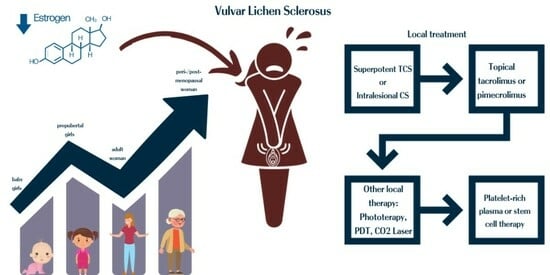
Graphical abstract

Journal Menu
► ▼ Journal Menu-
- JPM Home
- Aims & Scope
- Editorial Board
- Reviewer Board
- Topical Advisory Panel
- Instructions for Authors
- Special Issues
- Topics
- Sections & Collections
- Article Processing Charge
- Indexing & Archiving
- Editor’s Choice Articles
- Most Cited & Viewed
- Journal Statistics
- Journal History
- Journal Awards
- Conferences
- Editorial Office
Journal Browser
► ▼ Journal BrowserHighly Accessed Articles
Latest Books
E-Mail Alert
News
10 January 2024
Meet Us at the 53rd Annual Meeting of the Japanese Society for Spine Surgery and Related Research, 18–20 April 2024, Yokohama, Japan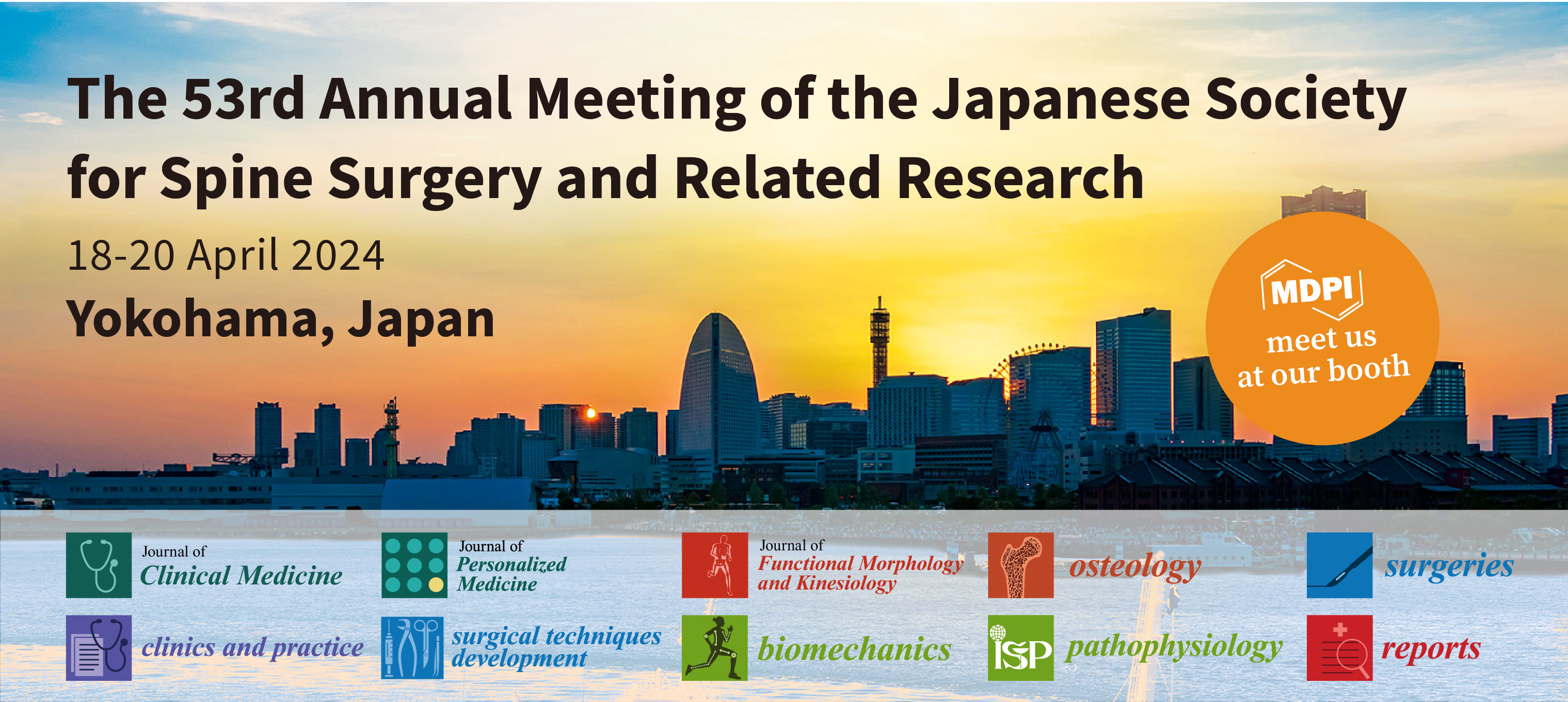
Meet Us at the 53rd Annual Meeting of the Japanese Society for Spine Surgery and Related Research, 18–20 April 2024, Yokohama, Japan

2 January 2024
MDPI Insights: The CEO's Letter #7 - Nobel Laureates Entrust MDPI with Their Research
MDPI Insights: The CEO's Letter #7 - Nobel Laureates Entrust MDPI with Their Research
Topics
Topic in
Healthcare, IJERPH, JCM, JPM, Applied Sciences, Technologies
Smart Healthcare: Technologies and Applications
Topic Editors: Gang Kou, Shuai Ding, Li Luo, Tian Lu, Yogesan KanagasingamDeadline: 20 January 2024
Topic in
Diagnostics, JCDD, JCM, JPM, Medicina
Cardiovascular Disease in 2023: Coronary Syndrome, Heart Failure and Structural Heart Disease
Topic Editors: Saverio Muscoli, Rafael Vidal-PerezDeadline: 31 January 2024
Topic in
Biomolecules, Diagnostics, JCM, Metabolites, JPM, Nutrients
Metabolic Syndrome, Biomarkers and Lifestyles
Topic Editors: Sang Yeoup Lee, Young Hye ChoDeadline: 30 June 2024
Topic in
Biomedicines, JCM, JPM
Current Challenges and Advances in Skin Repair and Regeneration
Topic Editors: Giovanni Salzano, Chiara CopelliDeadline: 20 July 2024

Conferences
Special Issues
Special Issue in
JPM
Personalized Therapy and Clinical Outcomes for Chronic Pain
Guest Editor: Federica GalliDeadline: 20 January 2024
Special Issue in
JPM
Novel Challenges and Advances in Complex Coronary Interventions
Guest Editor: Mario IannacconeDeadline: 30 January 2024
Special Issue in
JPM
Personalized Medicine for Schizophrenia Spectrum Disorders
Guest Editor: Nerisa BanajDeadline: 15 February 2024
Special Issue in
JPM
Clinical and Translational Research in Ophthalmology
Guest Editors: Eugene Yu Chuan Kang, Nan-Kai WangDeadline: 25 February 2024
Topical Collections
Topical Collection in
JPM
Genomic Medicine and Policy
Collection Editors: Christine Lu, Kurt Christensen, Nina Sperber
Topical Collection in
JPM
Advances of Emergency and Intensive Care
Collection Editor: Catalina Lionte
Topical Collection in
JPM
Personalised Medicine–Bringing Innovation to the Healthcare System
Collection Editors: Gordon McVie, Denis Horgan




